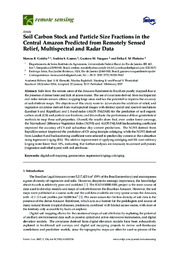Soil carbon stock and particle size fractions in the Central Amazon predicted from remotely sensed relief, multispectral and radar data.
Soil carbon stock and particle size fractions in the Central Amazon predicted from remotely sensed relief, multispectral and radar data.
Autoria: CEDDIA, M. B.; GOMES, A. S.; VASQUES, G. M.; PINHEIRO, E. F. M.
Resumo: Soils from the remote areas of the Amazon Rainforest in Brazil are poorly mapped due to the presence of dense forest and lack of access routes. The use of covariates derived from multispectral and radar remote sensors allows mapping large areas and has the potential to improve the accuracy of soil attribute maps. The objectives of this study were to: (a) evaluate the addition of relief, and vegetation covariates derived from multispectral images with distinct spatial and spectral resolutions (Landsat 8 and RapidEye) and L-band radar (ALOS PALSAR) for the prediction of soil organic carbon stock (CS) and particle size fractions; and (b) evaluate the performance of four geostatistical methods to map these soil properties. Overall, the results show that, even under forest coverage, the Normalized Difference Vegetation Index (NDVI) and ALOS PALSAR backscattering coefficient improved the accuracy of CS and subsurface clay content predictions. The NDVI derived from RapidEye sensor improved the prediction of CS using isotopic cokriging, while the NDVI derived from Landsat 8 and backscattering coefficient were selected to predict clay content at the subsurface using regression kriging (RK). The relative improvement of applying cokriging and RK over ordinary kriging were lower than 10%, indicating that further analyses are necessary to connect soil proxies (vegetation and relief types) with soil attributes
Ano de publicação: 2017
Tipo de publicação: Artigo de periódico
Unidade: Embrapa Solos
Palavras-chave: Geoestatística, Krigagem, Mapeamento digital do solo
Observações
1 - Por padrão são exibidas publicações dos últimos 20 anos. Para encontrar publicações mais antigas, configure o filtro ano de publicação, colocando o ano a partir do qual você deseja encontrar publicações. O filtro está na coluna da esquerda na busca acima.
2 - Para ler algumas publicações da Embrapa (apenas as que estão em formato ePub), é necessário ter, no celular ou computador, um desses softwares gratuitos. Sistemas Android: Google Play Livros; IOS: iBooks; Windows e Linux: software Calibre.
Acesse outras publicações
Acesse a Base de Dados da Pesquisa Agropecuária (BDPA) para consultar o acervo completo das bibliotecas da Embrapa.

